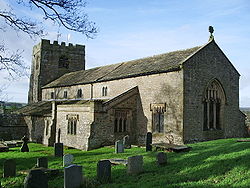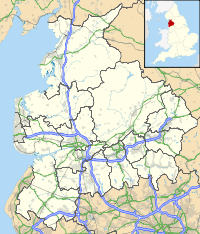- St Wilfrid's Church, Melling
-
St Wilfrid's Church, Melling 
St Wilfrid's Church, Melling, from the southeastLocation in Lancashire Coordinates: 54°08′05″N 2°36′59″W / 54.1347°N 2.6165°W OS grid reference SD 599 711 Location Melling, Lancashire Country England Denomination Anglican Website St Wilfrid, Melling History Dedication Saint Wilfrid Architecture Status Parish church Functional status Active Heritage designation Grade I Designated 4 October 1967 Architectural type Church Style Gothic, Gothic Revival Completed 1866 Specifications Spire height 55 feet (17 m) Materials Sandstone rubble
Stone slate roofAdministration Diocese Blackburn Province York Clergy Rector Rev Mark Harrison Cannon St Wilfrid's Church, Melling, is in the village of Melling, Lancashire, England. It has been designated by English Heritage as a Grade I listed building,[1] and is an active Anglican church in the united benefice of East Lonsdale,[2] the deanery of Tunstall, the archdeaconry of Lancaster and the diocese of Blackburn. Its benefice is combined with those of St Peter, Leck, St John the Baptist, Tunstall, St James the Less, Tatham, the Good Shepherd, Lowgill, and Holy Trinity, Wray.[3]
Contents
History
The earliest fabric in the church dates from around 1300 or earlier[1] but, as it is near the earthworks of a motte-and-bailey castle, it is possible that a church has been present on the site since the 10th century.[4] Most of the present church dates from the late 15th century,[1] with a restoration in 1763 when the clerestory was added and further restoration in the 19th century.[5] A chapel known as the Morley chapel was created as a chantry from a pre-existing chapel by John Morley who fought at Agincourt in 1415. It was heavily re-modelled in 1841 when the altar was removed. It was restored as a chapel in 1994–95.[4]
Architecture
The church is built in sandstone rubble with a stone slate roof. Its plan consists of a west tower, a nave and chancel under a continuous roof with a clerestory, north and south aisles, a south porch and a south chapel. The tower has diagonal buttresses and an embattled parapet. The west window of the south aisle dates from around 1300.[1] This window includes a fragment of medieval stained glass.[4] Internally, the aisle pews date from the 18th century but the nave pews, the screens, the pulpit, and the communion rails are from the late 19th century. In the chapel is an aumbry without a door and a squint. There are numerous memorial wall tablets. Discovered during the restoration and built into the vestry wall is a piece of Norman chevron ornament, part of a crucifix, and part of a grave slab.[1] The stained glass in the east window was designed by Henry Holiday and made by Heaton, Butler and Bayne.[5] The organ was built in 1891 by J. W. Walker of London.[6] The ring is of six bells which were recast in 1754 from three bells made in the 15th century by Rudhall of Gloucester.[4]
External features
In the churchyard is a sandstone sundial dating probably from the 18th century with a brass plate and gnomon which is listed Grade II.[7] Also listed Grade II are the Hodgson tomb chest dating from the early 18th century,[8] and part of the churchyard wall, the steps leading to the gate and the gate piers.[9]
References
- ^ a b c d e "Church of St Wilfrid, Melling-with-Wrayton", The National Heritage List for England (English Heritage), 2011, http://list.english-heritage.org.uk/resultsingle.aspx?uid=1165114, retrieved 19 May 2011
- ^ East Lonsdale, Diocese of Blackburn, http://www.blackburn.anglican.org/, retrieved 1 May 2008
- ^ Melling, St Wilfrid, Church of England, http://www.achurchnearyou.com/melling-st-wilfrid/, retrieved 27 October 2009
- ^ a b c d Lancashire Churches: Melling, St Wilfrid, Tony Boughen, http://www.lancashirechurches.co.uk/melling.htm, retrieved 30 April 2008
- ^ a b Pevsner, Nikolaus (2002) [1969], North Lancashire, The Buildings of England, New Haven and London: Yale University Press, pp. 176–177, ISBN 0-300-09617-8
- ^ Mellor St. Wilfrid, British Institute of Organ Studies, http://www.npor.org.uk/cgi-bin/Rsearch.cgi?Fn=Rsearch&rec_index=S00090, retrieved 17 August 2008
- ^ "Sundial south of Church of St Wilfrid, Melling-with-Wrayton", The National Heritage List for England (English Heritage), 2011, http://list.english-heritage.org.uk/resultsingle.aspx?uid=1071672, retrieved 19 May 2011
- ^ "Hodgson Tomb approx. 7 metres east of Church of St Wilfrid, Melling-with-Wrayton", The National Heritage List for England (English Heritage), 2011, http://list.english-heritage.org.uk/resultsingle.aspx?uid=1362541, retrieved 19 May 2011
- ^ "Churchyard wall bordering Main Street, with steps and north and south end, and gate piers at south end, Melling-with-Wrayton", The National Heritage List for England (English Heritage), 2011, http://list.english-heritage.org.uk/resultsingle.aspx?uid=1362560, retrieved 19 May 2011
Categories:- Church of England churches in Lancashire
- Grade I listed churches
- Grade I listed buildings in Lancashire
- English Gothic architecture
- Gothic Revival architecture in England
- Diocese of Blackburn
- Buildings and structures in Lancaster
Wikimedia Foundation. 2010.

